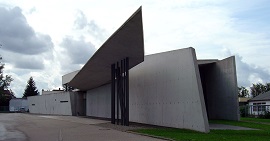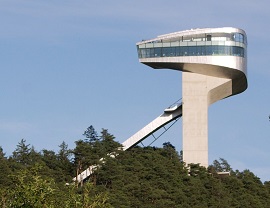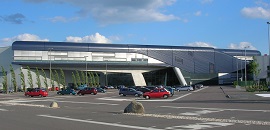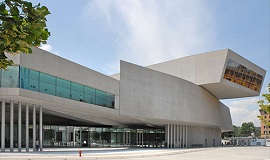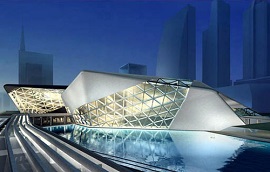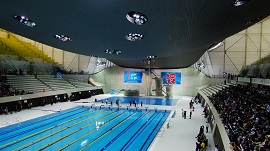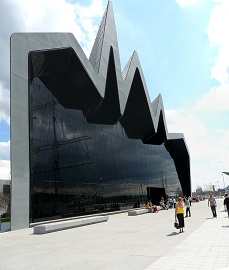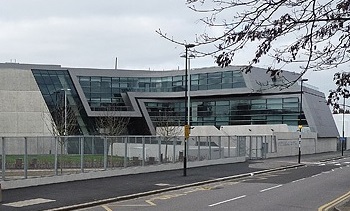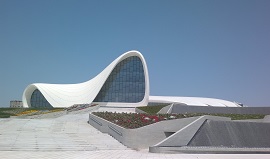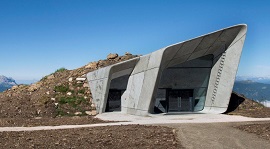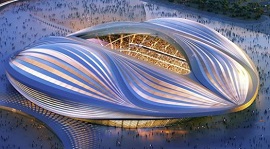Zaha Hadid
Dame Zaha Hadid was an architect known for her high-concept neo-futurist designs that gave her the label 'queen of the curve'. Born in Baghdad in 1950, she became the first woman in her own right to receive the prestigious Pritzker Architecture Prize in 2004, and the RIBA Gold Medal in 2015.
Initially studying mathematics in Beirut, Hadid moved to London in the early 1970s to attend the Architectural Assoication, where she later taught alongside the likes of Rem Koolhaas and Elia Zenghelis. London was to become the base for Zaha Hadid Architects which she founded in 1980. Throughout the 1980s she taught at the Harvard Graduate School of Design and a number of other international universities. During this period she began to be recognised for her innovative use of shapes, skewed perspectives and unusual geometric forms, notably in competition proposals for The Peak terminus in Hong Kong and the Cardiff Bay opera house that was later controversially cancelled.
It wasn't until 1993 that one of her designs was actually realised – the Vitra Fire Station in Germany, however, for all its ambition, it was criticised for its practical unsuitability by the firemen who occupied it. Towards the end of the 1990s, she designed the Mind Zone for the Millennium Dome and the first of the now-annual Serpentine Gallery Pavilion temporary structures.
Developing a reputation for seeking to push the boundaries of architecture and urban design, she experimented with the structural potential of concrete in the form of dramatic curves and angles on projects such as the Bergisel Ski Jump in Innsbruck (2002), and the Rosenthal Center for Contemporary Art in Cincinnati (2003). She also became involved in interior and product design, developing the Moon System Sofa for furniture manufacturer B&B Italia, and working with clothing brand Lacoste.
Perhaps her most famous building work is the Heydar Aliyev Cultural Center in Azerbaijan, with its sculptural skin bulging in smooth white waves. In 2010 and 2011 she won the Stirling Prize for the MAXXI museum in Rome and the Evelyn Grace Academy in London.
Despite many accolades, Hadid was no stranger to controversy, and often faced criticism for extravagant projects that spiraled over budget or were sponsored by states with questionable human rights records. Her design for the London Olympics Aquatic Centre suffered cost overruns, and her scheme for the Tokyo 2020 Olympics Stadium was cancelled due to escalating costs and local objections.
Sadly, Hadid passed away on 31 March 2016 when she was only 65 years old, with major projects ongoing such as the 2022 Qatar World Cup Stadium and a new airport terminal in Beijing.
Most notable buildings:
- Vitra Fire Station, Germany
- Bergisel Ski Jump, Innsbruck
- BMW Central Building, Germany
- MAXXI museum, Rome
- Riverside Museum, Glasgow
- Evelyn Grace Academy, London
- Heydar Aliyev Cultural Centre, Azerbaijan
- Messner Mountain Museum, Italy
- World Cup Stadium, Qatar
[edit] Related articles on Designing Buildings Wiki
- 600 Collins Street, Melbourne.
- Antoni Gaudi.
- Architect.
- Buckminster Fuller.
- Concept architectural design.
- D'Leedon, Singapore.
- Deconstructivism.
- Erno Goldfinger.
- Frank Gehry.
- Frei Otto.
- Masaryk Railway Station regeneration.
- Neo-futurism.
- Norman Foster.
- Parametricism.
- Port House, Antwerp.
- Richard Rogers.
- Salerno Maritime Terminal.
- Ted Happold.
- The architectural profession.
- The Architecture of Neoliberalism.
- UHAC, Saudi Arabia.
- Unusual building design of the week.
[edit] External references
- Zaha Hadid - Official site
Featured articles and news
BSRIA Sentinel Clerk of Works Training Case Study
Strengthening expertise to enhance service delivery with integrated cutting-edge industry knowledge.
Impact report from the Supply Chain Sustainability School
Free sustainability skills, training and support delivered to thousands of UK companies to help cut carbon.
The Building Safety Forum at the Installershow 2025
With speakers confirmed for 24 June as part of Building Safety Week.
The UK’s largest air pollution campaign.
Future Homes Standard, now includes solar, but what else?
Will the new standard, due to in the Autumn, go far enough in terms of performance ?
BSRIA Briefing: Cleaner Air, Better tomorrow
A look back at issues relating to inside and outside air quality, discussed during the BSRIA briefing in 2023.
Restoring Abbotsford's hothouse
Bringing the writer Walter Scott's garden to life.
Reflections on the spending review with CIAT.
Retired firefighter cycles world to raise Grenfell funds
Leaving on 14 June 2025 Stephen will raise money for youth and schools through the Grenfell Foundation.
Key points for construction at a glance with industry reactions.
Functionality, visibility and sustainability
The simpler approach to specification.
Architects, architecture, buildings, and inspiration in film
The close ties between makers and the movies, with our long list of suggested viewing.
SELECT three-point plan for action issued to MSPs
Call for Scottish regulation, green skills and recognition of electrotechnical industry as part of a manifesto for Scottish Parliamentary elections.
UCEM becomes the University of the Built Environment
Major milestone in its 106-year history, follows recent merger with London School of Architecture (LSE).
Professional practical experience for Architects in training
The long process to transform the nature of education and professional practical experience in the Architecture profession following recent reports.
A people-first approach to retrofit
Moving away from the destructive paradigm of fabric-first.
New guide for clients launched at Houses of Parliament
'There has never been a more important time for clients to step up and ...ask the right questions'
The impact of recycled slate tiles
Innovation across the decades.
EPC changes for existing buildings
Changes and their context as the new RdSAP methodology comes into use from 15 June.







